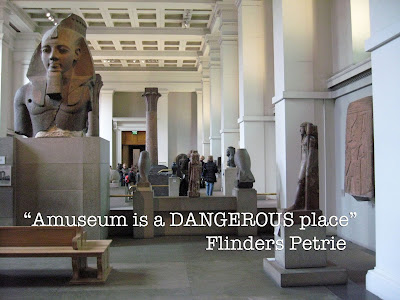 |
| The British Museum |
‘A MUSEUM
is a dangerous place.’
Sir
Flinders Petrie, pioneer British Egyptologist, first said those words, but
today Anson Hunter was thinking them.
A man had
followed him to the British Museum.
Who was
he?
Petrie
had been thinking about another kind of danger when he’d made his famous remark
about the dangers of museums. The founder of modern scientific Egyptology had
been alluding to the manner in which the early Cairo museum had dealt with a
royal mummy fragment found at Abydos, a single, bandaged arm, covered in
jewels, the only remains of First Dynasty king Zer.
The
curators took the jewels and tossed the arm way, the earliest royal mummy
remains ever to come to light. It was a mummy horror story to eclipse any
devised by the most febrile imagination, Anson had always thought, but right at
that moment his mind was on the other worry.
Anson
went up the steps and between the Ionic-style columns into the building. He
passed through a crowded reception hall to arrive in the Great Court beyond.
Above the
court, a tessellated glass and steel roof spread out overhead like a vast,
glowing net, catching clouds, blue sky and a spirit of illumination, while the
round, central building swelled like an ivory tower of learning. He crossed the
clean bright space before heading left to the door of the Egyptian section.
Inside
the dimmer light of the hall, a group of school children crowded around the
Rosetta Stone in its glass display case. Two little black girls peered inside,
their heads close together as they examined the stone, their hair braided in
cornrows. An African look, he thought. It linked his thoughts to Africa’s
greatest river, the Nile, and to Egypt’s irrigated fields that bounded it and
made Egypt the breadbasket of the ancient world.
He made
for the sculpture gallery.
Egypt,
both divinely monumental and naturalistic, surrounded him. Two statues of
Pharaoh Amenhotep III, powerfully formed in dark granodiorite, flanked the
entranceway to a hall, granting admittance, and inside, as stone slid by, other
familiar sights came into view, a red granite lion with charmingly crossed
forepaws, and further on, the statue of the Chief Steward Senenmut tenderly
holding the daughter of Queen Hatshepsut, the little princess Neferure, on his
lap - the child wrapped within his cloak and her face peeping out - then a
soaring, crowned head of Pharaoh Amenhotep in the background. And people
everywhere, creating a sound of buzzing like voices in a cathedral at prayer
time.
But he
barely saw or heard them. He paused at a figure standing on a pedestal near a
wall on the right hand side, almost overshadowed by a colossal granite torso of
Rameses the Great in the centre of the hall.
Khaemwaset,
the priest-prince and magician.
Anson
confronted the figure. The sculpture depicted the prince in a pleated kilt,
stepping forward while holding a pair of emblematic staves at his sides. The
conglomerate stone must have presented a technical challenge to the sculptor as
it was shot through with multi-coloured pebbles. It made Khaemwaset look as if
galaxies were exploding out of his chest.
A museum
label said:
Red
breccia standing figure... one of the favourite sons of Rameses II, the
legendary Khaemwese…
The label
used a variant spelling of the name Khaemwaset.
He looked
up at the face. Intelligent, sensitive features, faintly saddened. An air as
haunted as the face of the sphinx.
Anson
silently interrogated the statue.
Open up,
Khaemwaset. As one renegade to another, what do you really know? As a seeker of
forbidden power, did you open the sanctuary of Hathor, provoking fiery
destruction, plagues and pestilence on your father Rameses and his kingdom?
Legend tells that you found the magical Book of Thoth, so why not the disc of
Ra, too?
(Excerpt from Hathor's Holocaust)
 |
| Amazon Kindle and paperback, 2nd book in the Anson Hunter series |










